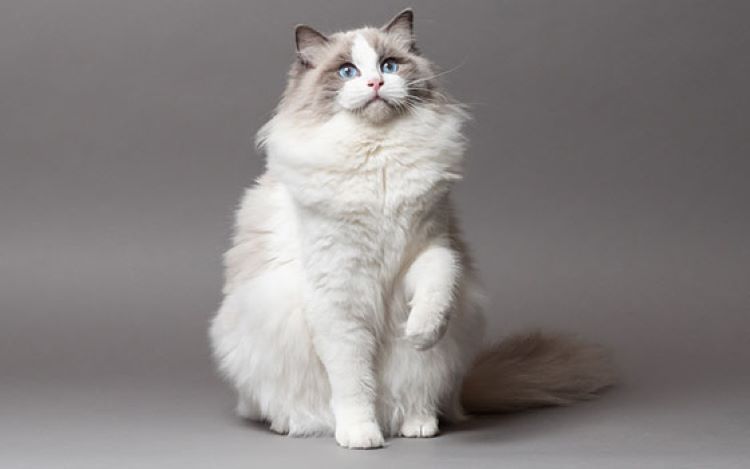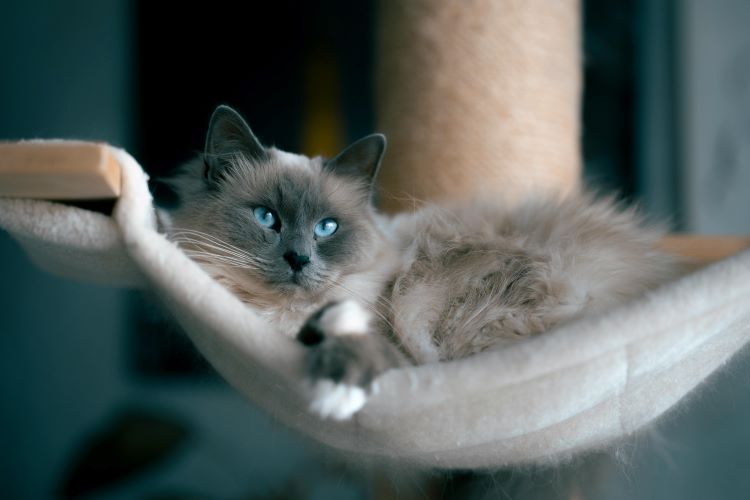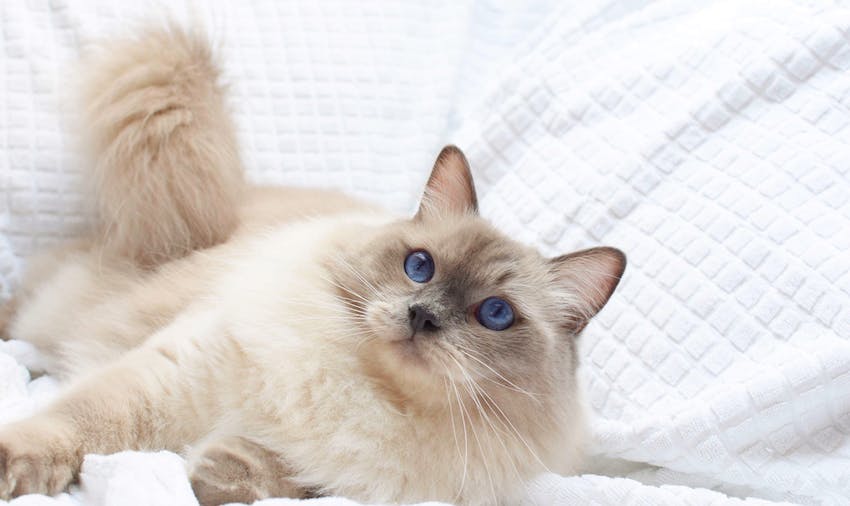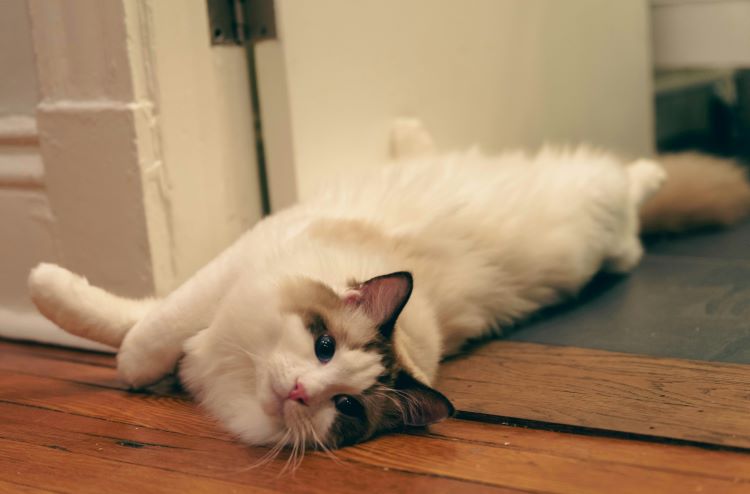Ready to help treat your pet to a healthy life?
All About the Ragdoll Cat: History, Breed Description & Care Tips
By : Trupanion Staff | Updated Jun 18, 2024

Many prospective cat parents find themselves having to choose between a playful pal or a cuddly snuggle buddy. But with the Ragdoll cat, it's the best of both worlds! Now one of the most popular domestic cat breeds, these fluffy kitties have purred and played their way into hearts and homes all over the world. But what exactly are these pets, and where did they even come from?
Whether you're considering adopting a Ragdoll yourself or just want to learn more about them, this breed guide has you covered with an in-depth look. Read on for breed definitions, history, care tips, and more!
What is a Ragdoll cat?
If you've heard of the Ragdoll before, there's a good chance you've also heard how it got its name. These cats tend to get extra relaxed when picked up or held, which many pet owners describe as going limp like a child's ragdoll. Many Ragdolls will also flop down on furniture and the floor when they want attention, often tilting themselves to the side and appearing to fall over.
As for appearance, Ragdolls have stunning blue eyes that can vary slightly in shade. Adding to their cuddly nature, these cats also have medium-long, fluffy fur that does not mat easily (though matting is still a risk without the proper care). They come in 6 different colors, including cream, lilac, chocolate, blue, red, and seal. Coat patterns vary, but generally fall into four specific categories:
- Bi-color: white and another solid color
- Van: white with small dots of color
- Mitted: white paws that look like mittens, often with white markings on face and chest as well
- Colorpoint: a pattern where darker color tones appear in "points" around the cat's body, specifically the ears, nose, and tail.
Is it a real feline breed?
Yes! Though the name may sound overly colloquial, The Cat Fanciers Association (CFA) first recognized the Ragdoll as a pedigreed feline in 2000 (though smaller groups recognized it before that). The breed was developed in the 1960s and has risen to prominence as one of the most popular cats in modern households. Though their different colors and patterns are recognized as part of the breed standard, Ragdolls are known for having coloring similar to the Siamese. And as mentioned, in addition to their looks, they are best known for their tendency to go limp when carried.
Fun facts
- The longest-living Janus cat (cat with two faces) was a Ragdoll named Frankenlouie. Usually, this rare congenital defect, called diprosopia, results in very short lifespans, but he lived until 15 years of age thanks to the care provided by its owner Marty Stevens.
- Often called a “puppy-cat” due to their temperament, Ragdoll cats absolutely love their people and prefer human company over the company of other cats (although they generally do well with other pets in the home).
- Ragdolls were the most popular cat breed in 2023 according to the Cat Fanciers’ Association.
- These cats tend to live between 10 and 15 years, though many have been recorded as reaching 20 years or even longer!
- They are medium-to-large cats — males tend to reach between 12 and 20 lbs. (5.4 to 9 kg) while females tend to stop growing between 8 and 15 lbs. (3.6 to 6.8 kg).
History of the Ragdoll breed
The origin of the Ragdoll breed is attributed to Ann Baker of California, who started breeding for the breed traits she desired in the early 1960s. She used three cats found in her neighborhood as the foundation for the Ragdoll cat, a long-haired white female named Josephine, Daddy Warbucks, a seal-mitted male, and Blackie, a solid black cat.
To keep control over the breeding standards of this new and adorable breed, Baker trademarked the name “Ragdoll” and formed her own registry for the breed, not allowing other breeders to register Ragdolls with other national or international registries.
Frustrated with Baker’s process, a small group of breeders broke rank and began developing the Ragdoll into what is recognized as the breed standard today by the Cat Fanciers’ Association and International Feline Federation. Another group split from Baker as late as 1994 due to her stringent rules and eccentric beliefs, creating another breed known as the Ragamuffin.
Despite achieving official recognition by the CFA prior, the Ragdoll cat breed name was not widely used until 2005, when Baker's registry and trademark expired. It was not renewed, allowing other breeders around the world to formally recognize their own kittens as Ragdolls.
The Ragdoll has been very popular since its introduction to the cat world. Its temperament and physical traits are quite desirable, and it’s a top choice for apartment dwellers due to its quiet nature. The breed was named the most popular breed of 2023 by the CFA, a title it has held since the early 2010s.

Do Ragdolls make good pets?
We sure think so! If you're looking for an easygoing, friendly cat breed with a fluffy coat, the Ragdoll may just be the kitty for you. This sweet breed loves to spend time with you and may follow you anywhere you let them — including into the shower! Playful, yet calm and quiet, these cats make excellent cuddling companions and family pets.
Ragdoll cats are also highly adaptable and easygoing, which makes them great for an indoor-only lifestyle. They’re ideal for urban homes with no access to outdoor spaces, including apartments.
Ragdolls are laid-back and tolerant, which enables them to get along well with other cats and kittens, animals, and young children.
They aren’t excessively demanding of attention but love their human companions, so even busy families can enjoy these kitties.
Similar breeds to consider
- Birman
- Himalayan
- Persian
- Norwegian Forest Cat
- Snowshoe
Behavior and training
It's important to keep in mind that all cats are different, and behavioral patterns can vary among individual Ragdolls. Overall, however, the Ragdoll cat is extremely tolerant and mellow and has been called the most relaxed, mild-mannered cat in the world. It has also been described as docile and loving. These personality traits result in cats who get along very well with other cats, family pets, and even young children.
Ragdolls are devoted to their humans and are happy to greet you upon returning home and giving you some cuddle time should you need it, but they are not overly demanding of affection.
Mental enrichment needs
Ragdolls are intelligent and can be trained to stay off counters and do tricks with little difficulty. Kittens are much more active than laid-back adults, but this breed enjoys chasing after toys, particularly those wielded by their guardians. Adults prefer more gentle activities, so engage them in games that will stimulate the mind, like trick training, food puzzles (Ragdolls are known for their love of food), and exploratory opportunities.
This breed is intelligent and combined with its love for food, can be trained easily to perform tricks such as giving high-fives, fist bumps, performing sit, spin, and laying down, among other things. It's nevertheless important to keep in mind that the Ragdoll tends to be a less active breed. Even though they may not run around much, it's a good idea to give them several places from which to perch and view their environment, especially windows, for some added mental enrichment.
Activities for Ragdolls
Have a Ragdoll of your own? It's important to provide plenty of activities to keep them mentally and physically fit. While the Ragdoll cat tends to be a less active cat, there are plenty of activities that this breed can enjoy! Here are a few suggestions:
- Pamper your Ragdoll with a grooming session that includes gentle brushing with a wire brush, nail trimming, and plenty of petting.
- Ragdoll kittens can be very active! Let them chase interactive wand toys with feather and mouse lures. Adults also appreciate chasing toys occasionally, but their play sessions may be a bit more subdued.
- Ragdolls love food! Give them treats and food in food puzzles or puzzle feeders. Start easy and make it more difficult as your cat figures out how to get the food inside.
- Easy DIY food puzzles to start with include putting food inside of ice cube trays or muffin tins, empty toilet paper tubes, and empty water bottles. Add toy “obstacles” in these containers that your cat must work around.
- Because Ragdolls are relaxed, tolerant, and enjoy being around their people, this is a breed that can be taught to enjoy trips with their humans. Taking walks in a pet stroller or a kitty backpack might be fun for your pet.

Grooming and health care
The Ragdoll has a medium-length coat that is kept healthy with weekly brushing, using a pin comb that reaches the skin and removes dead fur. These cats tend to be excellent at keeping themselves clean, meaning they won’t need frequent bathing. But you will see an uptick in shedding, usually twice a year during seasonal changes. Brush your cat frequently as they change between their summer and winter coat to prevent matting, especially under their armpits. Like all cats, Ragdolls benefit greatly from twice-monthly nail trimming, regular teeth brushing, and yearly well pet visits to the veterinarian to stay happy and healthy. Introduce your kitten to these experiences at a young age, keeping the experience calm and positive.
The Ragdoll cat, while lower energy and more docile than other breeds, still needs physical exercise to stay trim and healthy. While they aren’t big climbers, Ragdolls can learn how to play fetch and enjoy it since it’s a team activity with their family. In fact, any type of exercise that involves contact with their people may be enjoyable for these cats. This includes even just padding along behind you as you walk through the house but mix it up with a toy to chase or a mouse toy to fetch.
Common health concerns
Ragdolls tend to be a healthy cat breed overall, but their love of laying around can put them at higher risk of obesity. Other common health concerns include the following:
- Hypertrophic Cardiomyopathy (HCM): Around 30% of Ragdolls are estimated to carry the genes for this condition causing thickening of the heart walls, leading to heart failure. Regular veterinary check-ups and screening can help manage this condition.
- Polycystic Kidney Disease (PKD): A hereditary condition where fluid-filled cysts develop in the kidneys, potentially leading to kidney failure. Genetic testing can identify carriers.
- Feline Infectious Peritonitis (FIP): A serious viral disease that can be fatal. It's caused by a mutation of the feline coronavirus.
- Bladder Stones: Ragdolls may be prone to developing bladder stones, which can cause urinary issues. Proper diet and hydration are key preventive measures.
- Dental Issues: Like many cats, Ragdolls can suffer from dental problems, including gingivitis and periodontal disease. Regular cleanings may be needed to prevent serious issues.
Schedule routine veterinary appointments to help keep your cat healthy and catch health conditions early. It's also a good idea to consider cat insurance to prevent the cost of surprise conditions from being obstacles to your pet's treatment.

Ragdoll cats in pop culture
Ragdolls are beloved for their mellow nature and cuddly appearances.
Famous people with a Ragdoll cat
- Taylor Swift (Singer)
- Seth Green (Actor)
- Holly Willoughby (TV Host)
- Joe Rogan (TV & Podcast Host)
- Lalisa Manoban (Singer)
- Fredrik Backman (Author)
- Anne Rice (Author)
- Freddie Mercury (Singer)
- Jodie Marsh (Model)
- Giada De Laurentiis (Chef)
Famous Ragdolls
- Grumpy Cat, while not purebred, had some Ragdoll in her
- Matilda III was the former mascot of New York City’s Algonquin Hotel
- Merlin the unimpressed social media celebrity
- Frank and Louie, also known as "Frankenlouie," the two-faced (Janus) cat
